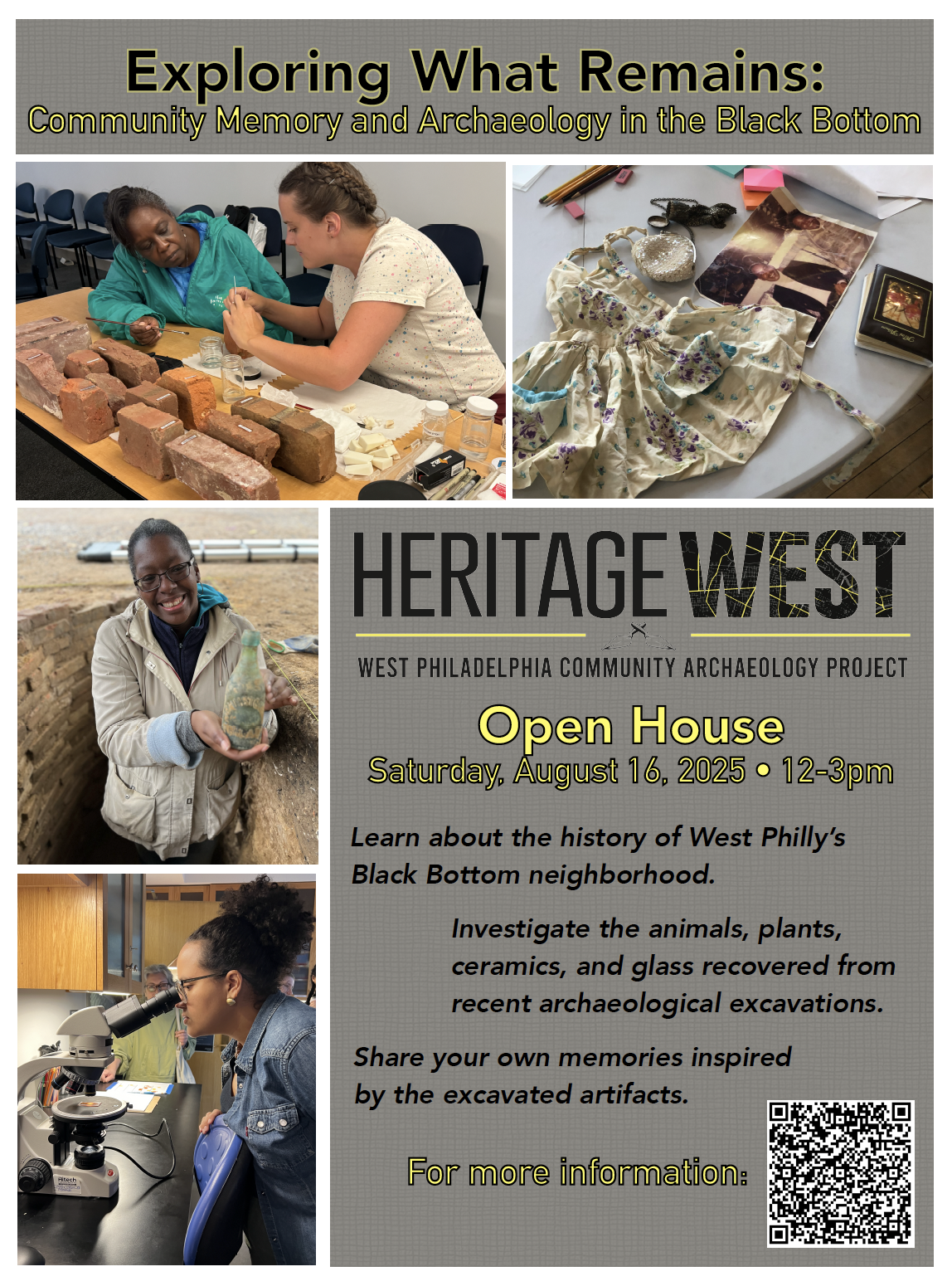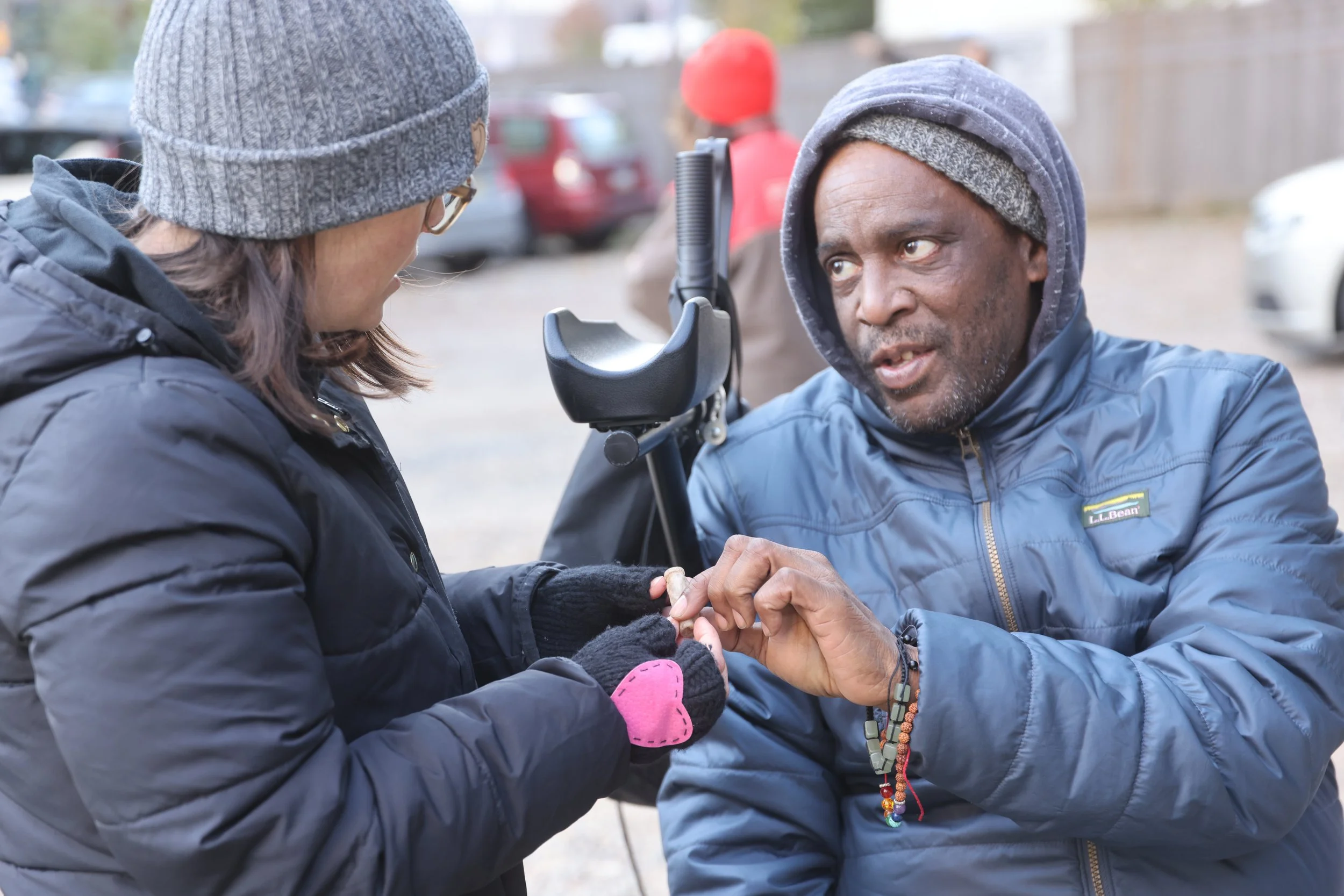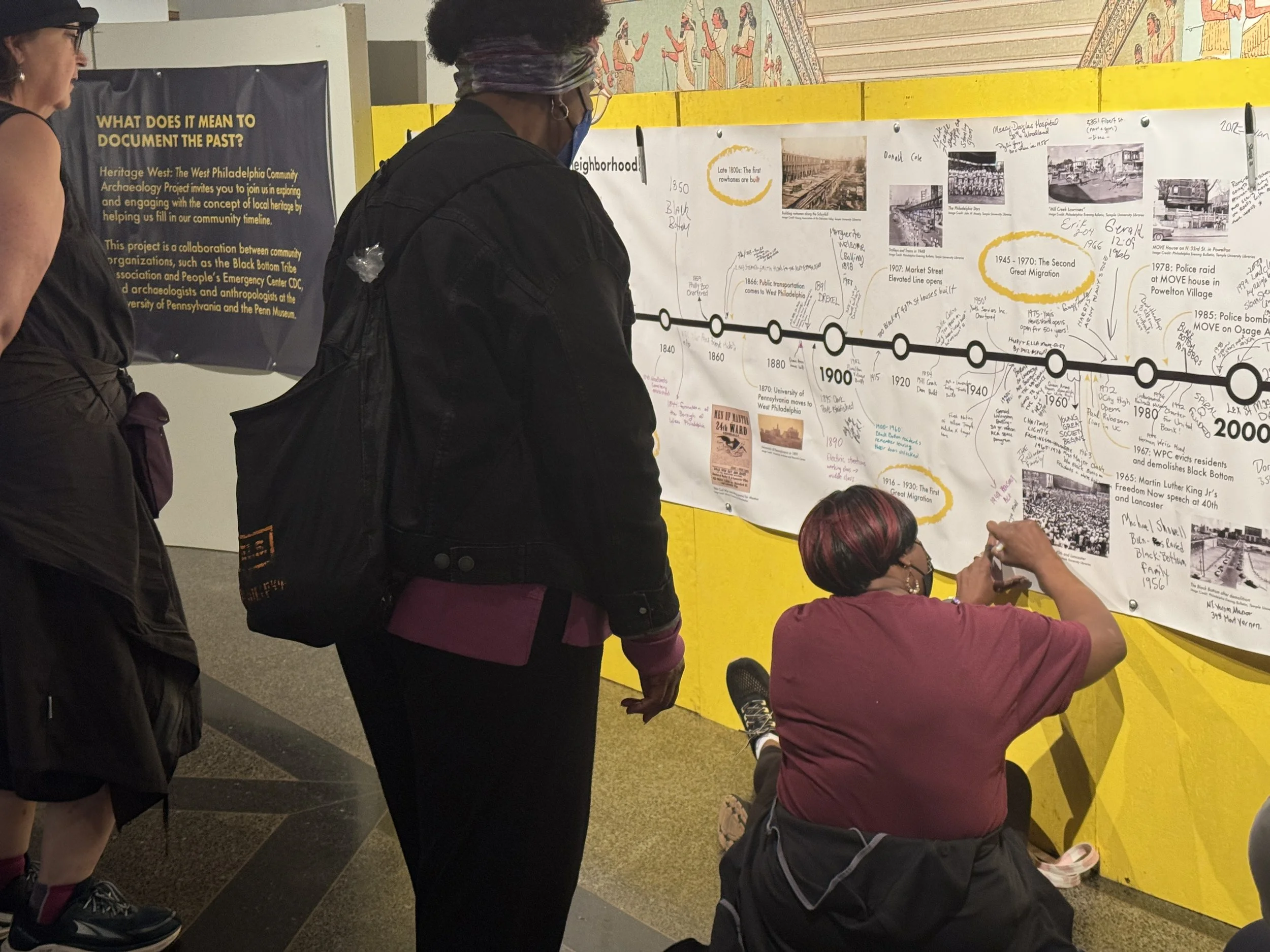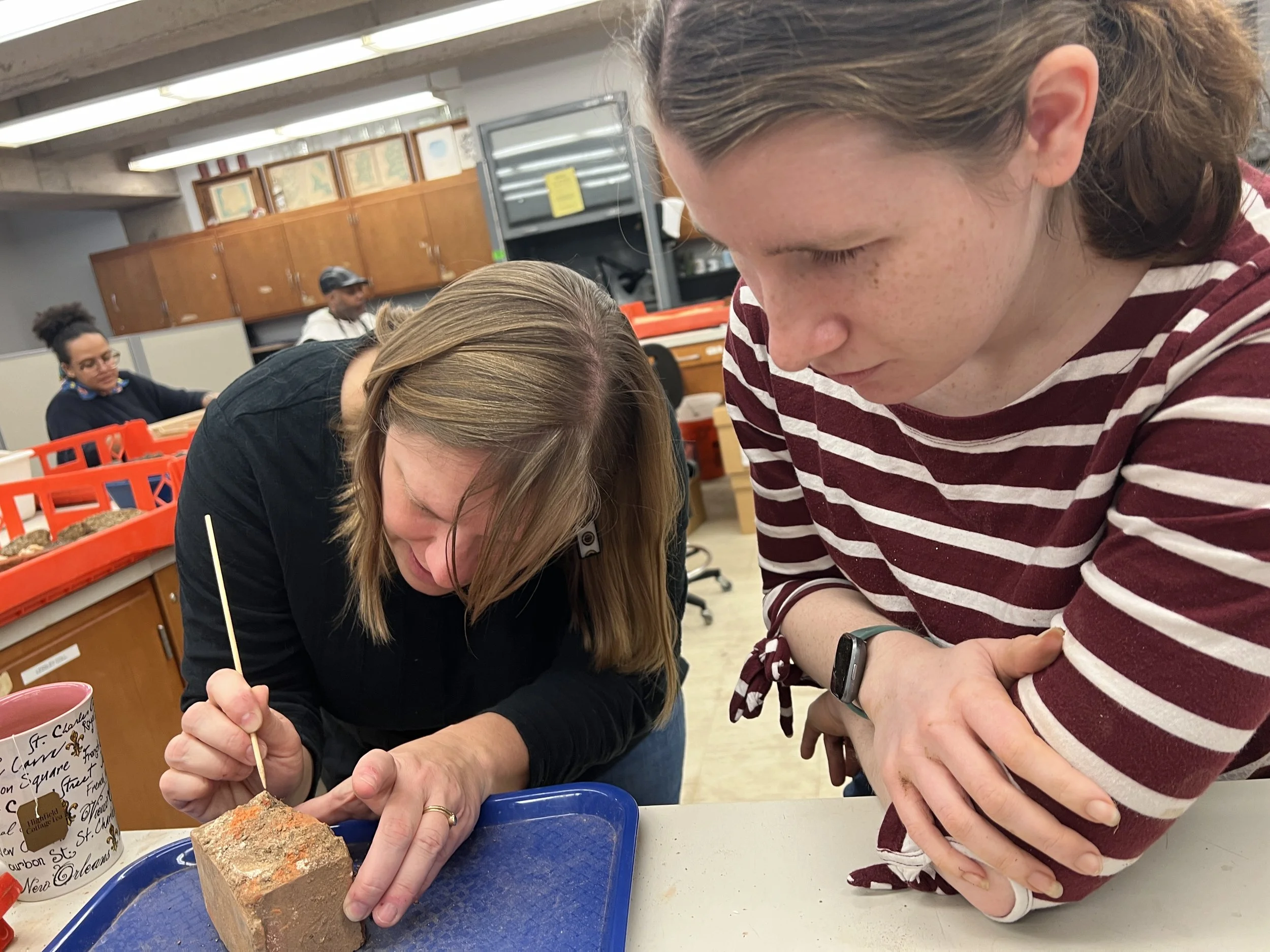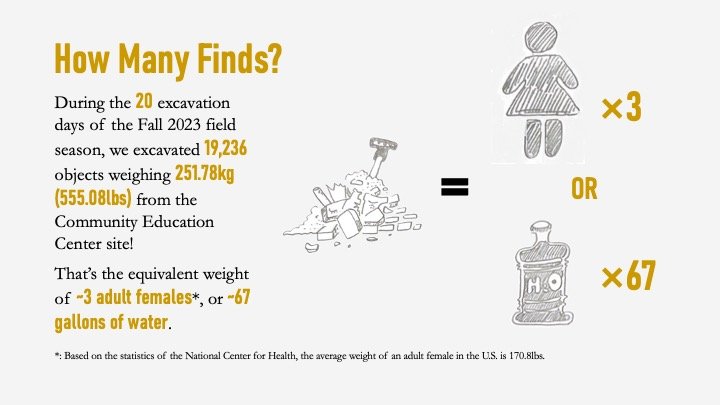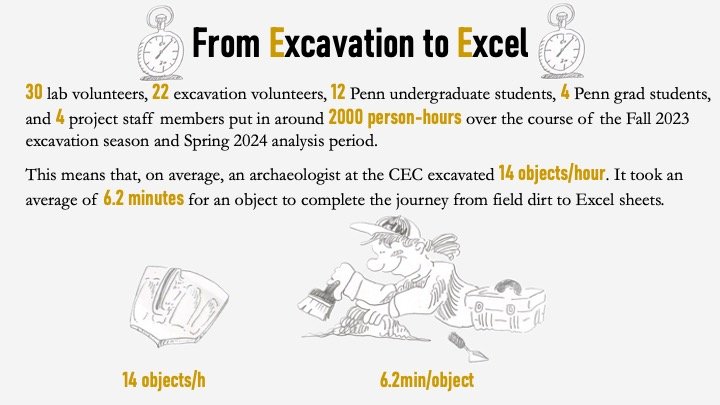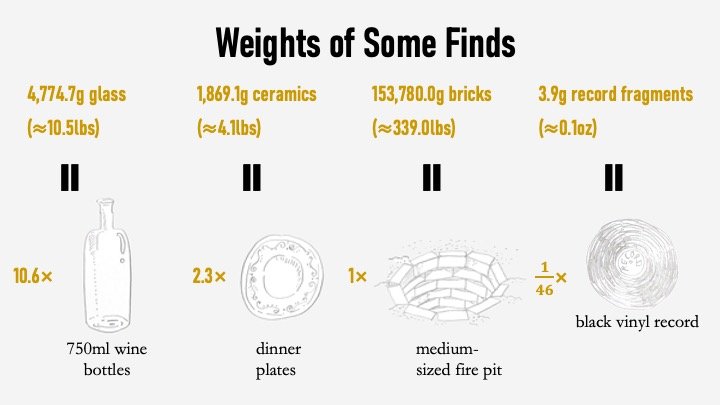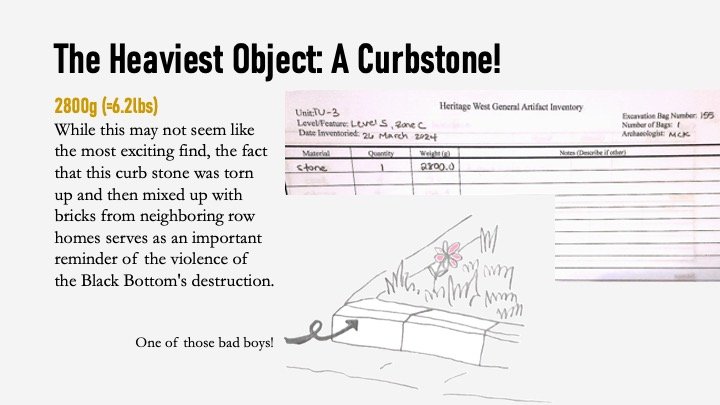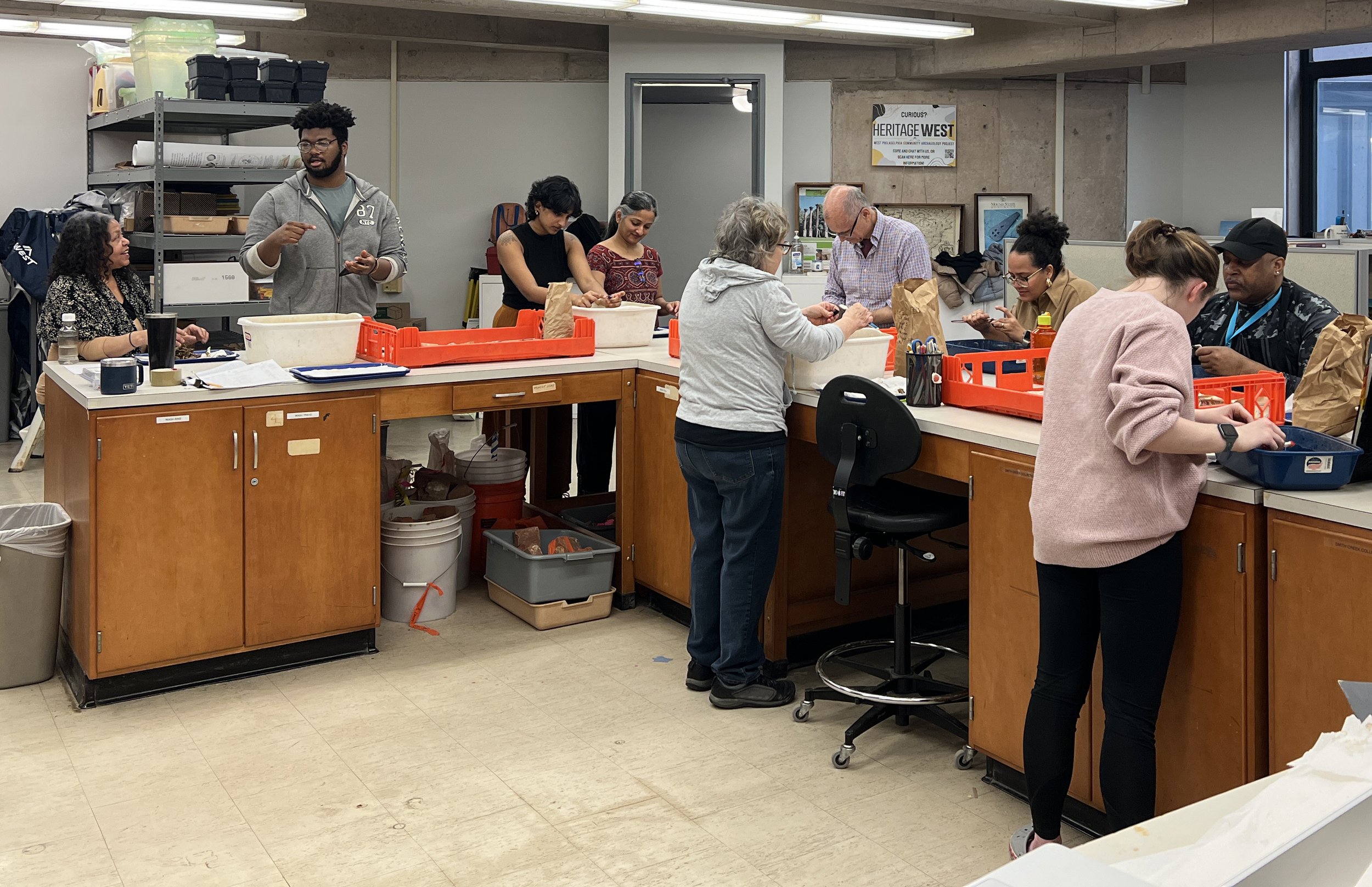Exploring What Remains: Community Memory and Archaeology in the Black Bottom
Please join us for an open house event at the Penn Museum to learn more about Heritage West, a community-led excavation that explores the history of the Black Bottom neighborhood by uncovering the lives of residents whose homes once stood behind the Community Education Center on Lancaster Avenue.
This free event will be held in Classrooms L1 and L2. When you enter through the Main or East Entrance, say you are here for the “Heritage West Event” and they will be able to direct you to the right place!
The following interactive stations will be available, allowing you to participate hands-on in historical and archaeological research in a wide variety of ways:
Oral History: Memories of the Black Bottom
The voices of former residents and descendants are essential to the project. Contribute your own memories, reflections, and community knowledge to bring depth and meaning to the material finds—bridging the past and present through lived experience.
Map and Timeline: Memory in Space and Time
Explore how the neighborhood changed over time through historical maps, photographs, and a community timeline. Contribute your own memories to the collaborative timeline and map! This station shows how Black Bottom transformed and places our excavation within the broader story of West Philadelphia.
Plants and Animals: The Archaeology of Food in the Black Bottom
Charred seeds, bones, and shell fragments reveal what people ate and how they interacted with their environment. Learn how studying plant and animal remains helps archaeologists reconstruct diets, foodways, and local ecosystems.
Ceramics and Glass: The Archaeology of Daily Life in the Black Bottom
Ceramic fragments from historic plates, bowls, and teacups and glass artifacts from bottles to window panes tell stories of daily life, family meals, and identity. Learn how archaeologists analyze style, material, and manufacturing marks to trace connections across time, class, and community.
Conservation: Taking Care of What We’ve Found
From painted plaster and bricks to beautiful jewelry and buttons, archaeological finds are fragile and need careful cleaning and preservation. This station shows the tools and techniques we use to stabilize objects, prevent decay, and prepare artifacts for study and display—ensuring they last for future generations.
Lives from the archives (part 1)
The ultimate goal of any archaeological project is not to find artifacts, but to figure out what we can learn about people and their cultures from those artifacts. When archaeologists investigate the recent past, this means exploring through historical records in addition to excavated objects to piece together fragments of people’s lives—a draft card, a census record, a city directory—so that we may reach a more complete story of life in West Philadelphia. Here we focus on what the historical records can tell us about the people who lived near the intersection of 35th St. and Warren St. This is the first post in a short series on some of the insights from the archives we have learned so far. Stay tuned for more!
Henry Johnson’s 1917 WW1 draft card (Ancestry: World War I Selective Service System Draft Registration Cards, 1917-1918. Washington, D.C.: National Archives and Records Administration)
Henry Johnson was born in Abbeville County, South Carolina in 1895 to William and Lela Johnson. At some point between 1910 and 1917, Henry went north, eventually finding work as a waiter and living at the corner of Warren and 35th St. when he filled out this draft card in 1917. Rosey T. Jones was also from the South, born in Virginia in 1880. By 1910, she was a widow living in Philadelphia, and rented a home at 26 N. 35th St. She then rented rooms in this home to three other Black women from Virginia who census records indicate worked as servants, the most common profession for recent Black female migrants in Philadelphia at a time where racism severely limited job opportunities for Black men and women.
Rosey Jones and boarders (1910 Census)
Likewise, Stonewall and Mary Jones, Stonewall’s mother Sarah, and their two lodgers were also from Virginia. Their children, however, were born in PA, as Stonewall and Mary had lived in Philly since the 1890s.
Mary and Stonewall Jones, and family (1910 Census)
These stories reflect some of the dramatic changes West Philly has seen since its emergence as an urban expansion of Philadelphia west across the Schuylkill in the 1800s, and hint at some of the difficulties archaeologists and historians face when trying to reconstruct community histories. As this post from the West Philadelphia Collaborative History Center outlines, West Philly was 83% U.S. born White in 1900, and would not become majority Black until 1960. While Black communities had existed in West Philly since the early 1800s, the most dramatic transformation in their size occurred through the Great Migration, which involved the movement of 6 million Black Americans out of the Jim Crow South between 1910–1970 to northern and western cities. The pull of the Great Migration was economic opportunity, especially during World War I as labor demands skyrocketed. In 1916 for example, the Pennsylvania railroad company offered free transport north to any Black southerner who was willing to ride the train to work the Philly railroad yards. However, there was also the push of Jim Crow and White terrorism in the South. For example, we cannot not know why exactly Henry Johnson migrated from Abbeville, South Carolina to West Philly prior to 1917, but we do know that in 1916 the largest Black landowner in Abbeville, Anthony Crawford, was lynched by a white mob that never faced punishment.
We’ve been compiling census data to get a better sense of when and how the neighborhood where we have been excavating changed, but it has proven difficult. The Black Bottom was never a designation used in the census, and the neighborhoods that census workers did identify changed regularly. For that reason, putting together a record of how the population of the Black Bottom changed through time is very complicated. However, we were able to reconstruct the demographics for all of the households that lived on Warren St. between 34th St. and 36th St., as well as those that lived on 35th St. from Warren to Lancaster from 1880–1950. In other words, this table gives you an idea of how the immediate neighborhood would have changed for the residents of the houses we excavated.
Bromley’s 1895 Atlas of the City of Philadelphia
Neighborhood population change from US Census Data
The complications of home ownership, renters, and subletters creates real challenges to connecting the artifacts that we excavated to the migration narratives mentioned earlier. From 1850–1910, the homes at the corner of 35th and Warren had relatively little turnover, and often the owners lived in the home. However, beginning in 1910, these wooden twin structures that we excavated, entered a period of rapid turnover. The homes were split into multiple formal and informal housing units, with some people only staying for a year or two. To understand how this can make archaeological interpretation complicated, consider this 1909 penny recovered in the basement of 32 N. 35th Street... who did it belong to? We know Stonewall, Mary, and their children lived there in 1909 and 1910, but in 1912 when Mary gives birth to her 7th child Emily, the birth certificate records a home birth down the street at 3429 Warren St. By 1920, Joshua and Mary Burnett are living at 32 N. 35th Street with their 6 children. Considering that coins tend to circulate for years if not decades, we have no way of conclusively answering: who lost their penny?
1909 penny recovered in excavations.
Instead, what this post has hopefully communicated and what future archival insights from the project will explore, is that combining artifacts and archives is messy and complicated, but that doesn’t mean we can’t learn new things, it just requires asking different types of questions. Rather than ask who owned a specific artifact, we can ask what role that artifact played for the type of people living in the neighborhood? When we find discarded oyster shells in the privy, we can’t know who had oysters for dinner. But with community involvement and oral histories, we can discuss oyster recipes, memories of New Years Eve meals, and even debate where the best seafood vendors were located. As the archives indicate, the people who moved to West Philly and formed what would eventually be called the Black Bottom came from a wide range of places, mostly in the South, bringing with them their own cultural and culinary traditions that they then adapted to living in West Philadelphia.
The connections between artifacts, archives, and memories can be difficult to untangle, and sometimes require some speculation. For example, Mary Norman, who along with her husband Stonewall were the first Black residents of 32 N. 35th street, was born and raised in West Point, King William County, Virginia, a coastal town on the York River that in the late 1800s had a thriving industry based on…oysters.
Oyster Pie recipe from What Mrs. Fisher Knows About Old Southern Cooking (1881) by Abby Fisher. This is one of the earliest known written oyster recipes authored by a Black chef.
Photogrammetry… seeing our units in 3D!
Most archaeology happens after the digging is over, and Heritage West’s work is no different! Since the close of excavations last November, the team has been focused on analyzing, interpreting, and documenting the finds from our four excavation areas at the Community Education Center in the North American Archaeology Lab at Penn. You can read lots of fun statistics about what we found in these early phases of analysis here. The success of our excavations and the fantastic effort on the part of our students and community volunteers in the lab last year means that we can keep being productive during the next phases of the project. Stay tuned for updates on more ways to get involved!
Now for an update on what we’ve been up to this fall, from Graduate Research Assistant Arielle Hardy.
Archaeology is inherently a destructive practice—once you dig the dirt out of the unit, you can never put it back in the same exact way—so ongoing documentation is a critical step in preserving the records of our excavation. Since our trenches were reburied (or “backfilled” in archaeology-lingo) when digging closed in November 2023, one of the first things we wanted to do was create a record of what they looked like at the end of the season. As we continue to process finds, this will help us understand where exactly objects were found in the ground, and reconstruct the process and timeline (or “phasing,” to use another archaeological term) of certain human actions that we saw while excavating… from the demolition of the homes in the 1960s, to the throwing away of garbage in the privy by the school in the 1930s and by the household on 35th St. back to the 1870s!
One of the best tools we have for this type of documentation is called photogrammetry. Photogrammetry is an archaeological technique that uses two-dimensional photographs—taken with a normal camera—to create three-dimensional digital models of objects and environments. By taking pictures from multiple angles, you can digitally stitch together a 3D image of almost anything, from bottles, to archaeological trenches, to people!
In these photos you see project director Megan Kassabaum and student Nikki Meyer taking photos of our excavation units during the last week of fieldwork in November 2023. In the background you can see various other students, staff, and volunteers helping to provide shade for the photographs.
Several computer programs help to build these types of models, and some favorites for our team members are Metashape and RealityCapture, but many phone apps (for newer iOS and Android devices) are capable of producing low resolution models too. Digital rendering is an important non-destructive method which helps preserve cultural heritage and communicate archaeological findings, making this material remotely accessible to local communities, cultural stakeholders, students, and researchers.
This fall, our team has been using the photographs taken of our four units at the end of excavation to build these digital models. We will be using them in our object documentation and analysis over the coming months, but the best part is they are publicly accessible too! We encourage you to check them out yourself by clicking on each of the four models below. (You can also find them in a bigger format on Sketchfab by searching “HeritageWestPHL”). Keep a lookout for additional models of finds that we will be uploading there throughout the spring!
The CEC Site, by the numbers…
Hi all! I’m Qi Liu, the summer intern for the Heritage West project.
Over the past month, I combed through the object data recorded during the 2024 Spring lab season and used it to construct an Excel database for the project. So, seven months after the 2023 Fall field season ended, we finally have a bird’s-eye view of what we dug up! Of course, more in-depth analyses of this archaeological data are on their way, but we’re eager to share the preliminary results with everyone who’s been interested in and supportive of the project. In this blog post, we hope to show some general statistics of the excavation, put into perspective what archaeological work is like, and—most importantly—share our feelings of satisfaction and pride over the excellent work done in the past year.
P.S. from the Project Directors: If you want to read more about how amazing Qi is, you can check out this article about her in Penn Today!
Spring Lab Work
Our final lab day for Spring 2024 was a week ago and we have just finished getting everything cleaned up and put away. Over the last three months, the North American Lab has been bustling with project staff, students, and volunteer community archaeologists. We’ve held open lab hours two days per week, during which over 30 dedicated community archaeologists put in over 350 hours of hard work helping us process the collections from the Fall 2024 excavations at the Community Education Center (CEC)!
February was spent washing all of the recovered artifacts. Because excavation happens so fast, washing everything is a real process of discovery and we identified many amazing objects that hadn’t attracted our attention in the field. Here are some photos from the washing phase (click to see larger versions):
March and April were spent sorting all of the newly cleaned objects. We carefully examined each object and assigned it a category based on material type, function, and what it can tell us about human behavior. We counted and weighed all of these objects to create a full artifact catalog, and all of our community archaeologists added important notes that will guide our future detailed analyses. Here are some photos from the sorting phase (click to see larger versions):
These are just the earliest steps of our analysis of the collections from the CEC, but we’ve already learned so much. We’ve learned about the abundance and importance of coal for heating the homes that used to stand behind the CEC…. we’ve learned that people painted their walls in a huge variety of beautiful colors… we’ve learned about some of the various ways residents of the Black Bottom cooked and ate their meals, made their livings, and entertained themselves with hobbies… and we have learned more about the violent destruction of their community. Future analyses will focus on better understanding some of these stories and our next steps will collaboratively consider how to best share them with the public in meaningful ways. We look forward to sharing opportunities to get involved with those next steps soon!
For now, we want to extend a huge thank you to ALL of the amazing community archaeologists who joined us this spring, including many Penn students as well as the following volunteers (listed in order of how many days they spent in the lab with us):
Erik Weaver
Darnell Holmes
Marina Fonseca
Frani Rehbun
Louisa Pollack Pruitt
Nandini Subramaniam (and her mom!)
Alex Seng
Lydia Parke
Marty Ferris
Jantra Morris
Miranda Mathias
Frances Conwell
Robin James
Bryan Harris
Malaika Mumeka
Merryl and Ezra Gladstone
Shaylee Kish
End of Season Unit Updates
Our Fall 2023 excavation season ended on November 17th. Over the course of ten weeks, 12 Penn undergraduates, 4 Penn graduate students, and 22 community volunteers worked together to excavate four units. In this post we summarize what we have learned so far… but 80% of archaeology happens AFTER the excavation, so there is still lots more to learn… lab work will begin in January (with dates and times TBA very soon)!
Test Units 1, 4, and 5: 32 N. 35th Street (Structure)
This unit, located on the former site of a wooden twin home built in the early 1850s, consisted of three adjacent 1 meter x 1 meter (about 3 foot square) units. We uncovered a corner of the stone house foundation and excavated part of the basement, which had been filled in with trash and rubble when the house was torn down in the 1930s. A 1909 Indian Head penny, a diaper pin, and many fragments of plates and bottles were uncovered in the basement. These artifacts start to paint a picture of what life may have been like for the people who lived at 32 N. 35th Street from the 1850s to the 1930s. Abundant iron fragments near the floor, including the pipe pictured below, hint that household industry may have taken place in this basement.
Test Unit 3: 32 N. 35th Street (Privy)
The circular outline of this brick-lined privy (or outhouse) was visible on the surface of the CEC parking lot. Over the course of our excavation, we dug over 5 feet into this time capsule of life in the Black Bottom. The cross-section of the privy shown below is a view through close to 100 years of history relating to the people who lived at 32 N. 35th Street, their surrounding community, and the nearby Quaker school. Artifacts like slate pencils and a lice comb tell us about life in the school, while buttons, fragments of decorated pottery, and food remains hint at what everyday life was like for the people living in the neighborhood. A complete bottle tells us that sometime in the 1860s or 1870s, somebody drank a Weiss beer made by Johnston & Co. This beer was bottled here in Philly and was light, effervescent, and sour, sometimes served with raspberry syrup.
Test Unit 2: Warren St. Rowhomes
This unit was placed in an area where our geophysical survey had suggested a large area of rubble where three brick rowhomes once stood along Warren St. These houses, and those around them, were torn down during the large-scale 1960s destruction of the Black Bottom neighborhood. Our excavations confirmed this interpretation of the geophysical data, as we dug through a portion of this brick rubble. In addition to small objects that had been abandoned when the houses were destroyed, we also found many fragments of plaster that tell us what colors people chose to paint their walls and curb stones that would have once lined streets throughout the neighborhood.
Test Unit 6: Front of the CEC Building
This unit was placed in the front yard of the CEC to draw in people walking along Lancaster Avenue. While we did not know if we would find very much here, it turned into one of our most exciting excavations. The top layers contained lots of coal and broken pottery related to activities happening in and around the CEC building over its long history. After we dug about 1 foot down, we began to uncover a lot of red fill made of ground-up bricks. The history and purpose of this fill is still a mystery, but we are hoping to learn more about when it was placed there by studying the artifacts from within it in the lab.
A special thanks to all of our amazing volunteers and students (only a small sample of whom are pictured here)! We can’t wait to begin the lab phase of the project in January!
September Unit Updates
Our semester-long excavation at the Community Education Center began in early September. Since then, our crew has included eleven community members and ten Penn undergraduates, who have been working in four distinct excavation areas on the CEC’s property. In addition, we have had countless visits from people passing by to ask what we’re doing, share stories, and even join in the excavation. In this post, our students summarize what we’ve learned so far!
Students and community volunteers screen the soil that has been excavated to recover small artifacts.
Test Units 1, 4, and 5: 32 N. 35th Street (Structure)
(Summarized by Lauren Davis, Lily Davis, and Ashley Ray)
This unit is located on the former site of a wooden twin home, built in the early 1850s; our excavation here consists of three adjacent 1 meter x 1 meter (about 3 foot square) units. Two units have begun to reveal wall remnants from one of the homes (visible in the first picture below), while another unit may contain part of the building’s basement (refer to this blog post for greater detail). A gravel layer (likely from the 1960s destruction of the site) separates modern debris, such as nails (like the one held by a community volunteer in the second picture below), Rain-blo gum wrappers, and electrical covers (like the one in the third picture below), with artifacts from the 1930s structures (such as the 1927 penny in the fourth picture below). Additional findings, such as ceramic and iron and glass slag fragments, indicate that the location could possibly have been a site of household industry, and glass bottle shards may have come from a nearby dairy farm or been otherwise used by the people who lived in the house.
Test Unit 3: 32 N. 35th Street (Privy)
(Summarized by Baoying Hu and Sydney Kahn)
The circular outline of this brick-lined privy was visible from the surface of the CEC parking lot (see the drawn map in the first picture below), a clear roadmap to an amazing collection of discarded objects from the past 100 years. There’s another visible privy on the lot, but we chose this one because it would have been within the property lines of 32 N. 35th Street, the subject Test Units 1, 4, and 5, and thus could give us a more complete picture of its residents’ lives. Our plan is to excavate one half of the circle (see the second picture below), allowing us to see a complete cross section of the privy’s history from its use as a latrine and dump for the house before 1930, through a layer of clayey, clean fill that was placed in the privy before its reuse as a dump by the Quaker school after 1930 (which would be the material that is closest to the surface). So far, we’ve dug about 3 feet down (see the third picture below), recovering artifacts like slate pencils, a cow bone, and a lice comb from the Quaker school layer, then a pipestem (held by one of the students in the fourth picture below), oyster shell, and thin glass shards—possibly from a picture frame—from layers within and below the clean fill. We aren’t sure how deep the privy goes in total, but, since there have been no known privy excavations in West Philly, we’ll be the first ones to find out!
Test Unit 2: Warren St. Rowhomes
(Summarized by Megan Kassabaum)
Our geophysical survey revealed a large area of rubble throughout the area of three brick Warren St. rowhomes that were torn down during the large-scale 1960s destruction of the Black Bottom neighborhood. Our first levels of excavation encountered the same layer of white gravel that was identified in the other units, which was laid down after the demolition. Underneath, students and community members (see the first two pictures below) began uncovering lots of broken bricks and other construction materials (nails, tile, and plaster), as well as some small artifacts such as a straight pin, pieces of shell, and a bone button. The bone button (shown in the third picture below) inspired a former Black Bottom resident to tell us a story about a woman who she remembered getting dressed up for church in outfits covered in “Buttons ‘n’ Bows,” a phrase that became her nickname. Last Friday, we uncovered a dense layer of brick (visible in the fourth picture below) that covers the bottom of our excavation unit, fits with what we expected to see based on the geophysical survey, and clearly shows how complete the destruction of the brick rowhomes was.
Test Unit 6: Front of the CEC Building
(Summarized by Sarah Hinkel and Nikki Meyer)
We went in not knowing what we’d find in this unit. We chose to put this unit in the front yard with the hopes of drawing in community members walking along Lancaster Avenue to engage with the project and share their experiences (see the first photo below for a view of the scene from the sidewalk and the second photo for a snapshot of community members touring the site). We have been excavating with shovels (see the third photo below) and are currently at a depth of 23 centimeters (9 inches); in the two levels we have dug, we have found pottery–including two white-and-blue fine porcelain sherds and a patterned red clay crock–metal, lots of coal, and plastic (see the fourth photo below) . As we continue moving forward we hope to investigate a dark feature in the soil, that we think may potentially be a pit, related to landscaping activity, or associated with a pine tree that used to stand in this spot.
International Archaeology Day Celebration (October 21st, 10am-3pm)
In honor of International Archaeology Day, Heritage West will host a special Saturday excavation day at the Community Education Center at 3500 Lancaster! Join us on Saturday, October 21st from 10am-3pm to participate in an archaeological excavation right here in West Philadelphia. There are many ways to get involved and learn about the seven homes that once stood at this location and were part of the vibrant Black Bottom neighborhood.
You're invited to:
Dig using a trowel or shovel to excavate in one of the units or sift soil to recover artifacts.
Watch archaeology in action, see some of the recovered artifacts, and learn about the history of the people who lived near Lancaster Avenue from the 1850s to the 1960s.
Or you can:
Share your stories of the Black Bottom neighborhood and Lancaster Avenue.
Join in kids activities like cookie excavations and flower pot puzzles.
For those interested in digging, all training and equipment will be provided. Please dress in clothes that you can move in and that you will not mind getting dirty. Rain date for the excavation is Saturday, November 4th.
In addition, Philadelphia poet Yolanda Wisher and architect and artist Nina Cooke John have teamed up to create a new public artwork at uCity Square, once a part of the Black Bottom. They will be hosting a clay tile-making workshop at the CEC from 11-1pm on International Archaeology Day! During the workshop, participants are invited to bring family artifacts to emboss into wet clay. (Your artifacts will go back with you). The pressings of your artifacts and others recovered from the archaeological dig will become part of the final artwork - remembering your stories of the Black Bottom.
Finally, all volunteers are also invited to visit the Penn Museum for free on International Archaeology Day! Hope to see you there and please don’t hesitate to reach out at heritagewestphl@gmail.com if you would like more information!
Refining our mission, growing our website
Faruq Adger is currently one of twelve Penn Museum Interns selected for the 2023 summer cohort. He has been working with Heritage West through the Academic Engagement Department, focusing his attention on refining the project’s mission and building out our website.
From Faruq: Working on the website was a rewarding experience in many different ways. I felt accomplished that my research and writing skills were valued and that I was able to contribute a great deal to the development of the website. During my research, I learned multiple new aspects of history about the Great Migration and life for Black Philadelphians during the 20th century. The information that stuck with me the most was listening and reading accounts of individuals who talked about their experiences within Philadelphia. I am thankful for being a part of this project for multiple reasons; however, illuminating true history and bringing awareness to the Black Bottom community is a fulfilling experience. I plan to continue unearthing the true history and character of communities and individuals from the biases, bigotry, and shame that surrounds them. This project is the first step in the right direction for righting the wrongs done to the Black Bottom community, and I am grateful that I am able to walk this path.
About this post’s guest author:
Faruq Adger is a Philadelphia native who grew up in Germantown. He is studying Cultural and Linguistics Anthropology with a minor in Africana Studies at the University of Pennsylvania. His overall goal is to apply his skills to inclusiveness within our society by disrupting embedded values of racism, sexism, homophobia, and colonization. Faruq wants to accomplish this goal by pursuing a career as a Director of Diversity, Equity, and Inclusion. Faruq began working with Heritage West through the Penn Museum Summer Internship program, conducting research and helping prepare the website text, including the first draft of the statement regarding the Black Bottom on our homepage.
About the Penn Museum’s Internship Program:
The Penn Museum offers nine-week fully paid summer internship opportunities for undergraduates, recent graduates, and graduate students from any college or university. Internships include two parts: a project-based placement in a Museum department and the Museum Practice Program, which includes orientation, weekly lectures, collections tours, and field trips to local museums. The internship concludes with final presentations shared by the interns.
Geophysical Survey at the CEC
A report on the preliminary geophysical survey of Heritage West’s future excavation sites!
Until recently, the space that is now the parking lot behind the Community Education Center (CEC) on Lancaster Avenue was home to at least seven residences, including some of the original West Philadelphia homes built in the 1840s. You can see the outlines of these houses in the image below, which overlays an 1895 map over a modern aerial photograph.
The CEC parking lot in 1895. (GPGN)
In the 1960s, the West Philadelphia Corporation used a variety of legal tactics and eventually bulldozers to remove residents and demolish the Black Bottom neighborhood. These destructive events and subsequent development of various high-rises suggest that almost nothing remains of the 19th and early 20th-century origins of the Black Bottom and its residents. However, the stability of the CEC building and surrounding grounds has acted as a buffer, making this parking lot one of the few if not only places in this part of West Philadelphia that could contain intact historic materials left behind by 1800s residents.
In February and March 2023, the Heritage West team worked with Dr. Chad Hill to conduct a geophysical survey of the parking lot and grounds surrounding the CEC building. Working with CEC permission, our primary goal was to use Ground-Penetrating Radar (GPR) and Electrical Resistivity (ER) to determine what evidence remained of the homes and yards that once lined Warren and Little Pine/35th St. Geophysical survey techniques allow us to look underground without excavation, providing a sometimes blurry but valuable perspective that can give us lots of important information and guide future excavation plans.
Dr. Chad Hill conducting geophysical survey in the CEC parking lot.
In this case, the GPR results, which can be seen in the image below, revealed a clear disturbance on the western portion of the parking lot. This is where the Warren brick rowhomes once stood and represents the edge of the demolition of the Black Bottom neighborhood in the 1960s. The red dotted lined on the image below represents where the bulldozers stopped, leaving a rubble pile of what were once brick rowhomes. Despite the violence of this destruction, you can still see faint vertical lines in the data, suggesting that some of the brick walls remain intact beneath the demolition debris.
The eastern side of the lot shows the foundations of two sets of twin homes (outlined in the image above with a green dotted line), constructed out of wood in the 1850s. Building A, in the lower right corner, has been partially intruded on by the 1960s rubble. We have been able to find a photograph of it still standing in 1961 (see below). Building B is better preserved, and you can see the filled in basement (the whiter rectangle in the far upper right corner), a probable small yard or porch (the black rectangle outlined in white just to the left of the basement), and a possible storage pit in the back yard. The fact that evidence of these structures still persists underground is exciting, as they were some of the earliest homes constructed in West Philadelphia. We will thus focus our upcoming excavation on these areas.
1961 photo showing ruins of an 1800s home behind today’s CEC building. (Philadelphia Department of Records)
About this post’s guest author:
Dr. Chad Hill’s is a Postdoctoral Fellow in Penn’s Department of Anthropology. His research focuses on the later prehistory of the Near East, with specializations in remote sensing, GIS, advanced image processing, and faunal analysis. He is the field director of the Galilee Prehistory Project, excavating Chalcolithic sites in the Galilee region of Israel, and co-Director of the Landscapes of the Dead project, using drones to monitor looting at Early Bronze age cemeteries in Jordan. As part of the Penn Paleoecology lab he is working on the Landcover 6k project, using archaeological, historical, and paleoenvironmental data to improve modern climate models.

